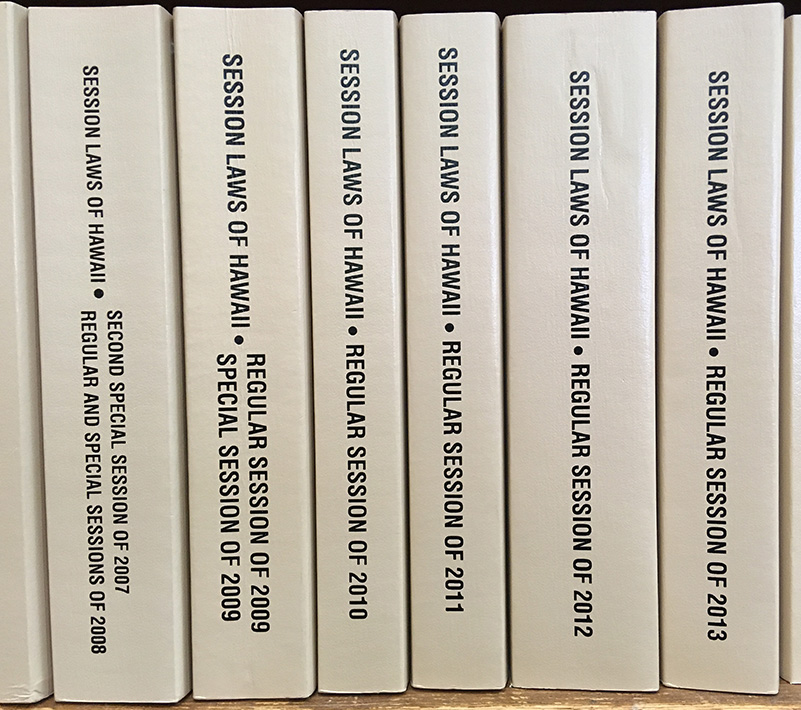Finding the Laws
At PAR, we focus on the legislative process and the advocacy involved in lawmaking. But what happens after a bill becomes law?
Each year, all the bills that become law are compiled in the Session Laws of Hawaii (SLH). If the new law adds to or amends any of the codified laws (the laws arranged in a systematic code) of the State of Hawaii, it will also be reflected in the Hawaii Revised Statutes (HRS), where the laws of a general and permanent nature go.
Not all new laws impact the HRS. For example, if the law is applicable only for a limited amount of time or contains temporary provisions (as is the case with legislative appropriations), it will be published in the Session Laws but not codified in the HRS.
Note that there are also rules published by the State departments governing how the new laws will be implemented – those are the Hawaii Administrative Rules (HAR).
To make it all a bit more understandable, read on…
Session Laws of Hawaii
Where ALL the Enacted Bills Are Published
The Session Laws of Hawaii (SLH) is an annual compilation of all the laws enacted by the Hawaii State Legislature in a session and arranged by act number (they are in the order that they became law).
Includes Full Text of All the Enacted Bills
- The compilation includes both laws that amend the HRS and those that do not (for example, budgets, appropriations, and temporary laws), as well as proposed constitutional amendments.
- The text of each is printed in full (with a few exceptions). This can be helpful, for several reasons. Some legislation starts with a purpose clause, which may provide background information or a statement of legislative intent. Also, one act may have numerous sections, affecting various laws or issues, and here you’ll be able to see the act in its entirety.
- The SLH also includes a useful index, tables showing which sections of the Hawaii Revised Statutes are affected by the acts, as well as lists of each measure’s committee report numbers.

Citations
When referring to a session law, just note the act number and the year, such as “Act 77, Session Laws of Hawaii 2014” or “Act 77, SLH 2014.”
Finding It Online
The SLH are now published online! You can find the list of acts for each session (as well as the index and other information) by selecting “Session Laws” from the drop-down menu under the “Laws & Research” tab on the Legislature’s website. Just select the year. NOTE: The Legislative Reference Bureau’s “Supplemental Information Relating to Bills Passed,” available on its Session Reports page, provides a table on laws affected by the bills passed (not necessarily enacted) during a particular session, and is helpful for the current year before the SLH is published and posted.
Published Volumes
Hard copies of the SLH are published in late November/early December and can be purchased from the Lieutenant Governor’s office. PAR has volumes back to the mid-1990’s, and there are hard copies from all the years downstairs in the LRB Library (Room 005).
Hawaii Revised Statutes (HRS)
The 14 Volumes of ‘Codified’ Law… Which Many of the Enacted Bills Affect
The Hawaii Revised Statutes (HRS) consist of 14 hardcover volumes and cumulative supplements that contain Hawaii’s codified laws. (“Codified” simply means that the laws have been arranged into a systematic code or plan.)
Standing Books of Law Incorporate Changes Dictated by Certain Enacted Bills
- The HRS is organized by “titles;” there are 38 of these titles, each containing laws pertaining to a discrete subject area.
- The changes made to the HRS are dictated by the text of the enacted bills. Remember how confusing all those [
cross outs] and underlines were when you first saw a bill that attempted to change an existing section of the HRS? Well, that Ramseyer format makes it very clear to the Revisor of Statutes precisely which words in the HRS should be taken out and what language should be added. If you have worked long and hard to have a law changed, it’s gratifying to look at the updated HRS and see how all those strike outs and underlines have been compiled.

- The HRS also includes the Constitution of the United States, the act creating Hawaii National Park, the Organic Act (concerning the Territory of Hawaii), the Admission Act, the Constitution of the State of Hawaii, and the Hawaiian Homes Commission Act.
- If you know the subject matter but are unclear where the law might fit in the whole arrangement, the HRS includes an especially helpful Index. There are also the Tables of Disposition, which show where sections of acts are codified in the HRS. (They also show how the laws of the Territory of Hawaii were codified into the HRS.)
- Wondering how a certain HRS section was established? At the end of each HRS section, in square brackets, you’ll find notations indicating the enabling legislation. The key to deciphering them can be found in the first volume, right before the table of contents, or in the list of abbreviations (PDF).
Citations
When referring to a section of the HRS, the common nomenclature is to use the section symbol (§), for example, “Hawaii Revised Statutes §329-122” or “HRS §329-122.”
Finding It Online
An online unofficial version of the HRS is available on the Legislature’s website. To go to a volume or section, select “Hawaii Revised Statutes” from the drop-down menu of the “Laws & Research” tab. Select the volume and then hone in on the section you’re interested in. There are also links to the Table of Contents, Indexes, and the Tables of Disposition at the top of the page. To look for a word or phrase in the volumes, use the search box at upper right — just select “Hawaii Revised Statutes” as your search type.
Published Volumes
The HRS annual updated volumes and supplements are published near the end of the calendar year and can be purchased from the Lieutenant Governor’s Office. *Note: When using the printed HRS, check a volume’s “supplement” first to see if there have been updates since the hard-bound volume was published. If the section you’re interested in doesn’t appear in the supplement, that means the section in the hard-bound volume is current.
Hawaii Administrative Rules (HAR)
Each Executive Branch Department Establishes Rules of Operation…
The Legislature’s creation of new laws may affect the operations of one or more of Hawaii’s numerous departments or agencies that make up the government’s executive branch.
Hawaii Administrative Rules (HAR) are operating procedures the executive agencies establish via rulemaking.

Executive Branch Rules
In order to implement many of the laws passed by the legislature, the departments must be able to create their own policies, procedures, and rules. Chapter 91 of the HRS governs “Administrative Procedure” and outlines the necessity and procedures for establishing the rules that govern how the State departments will function.
- Proposed rules go through an extensive public review and hearing process.
- The details of how a law is to be executed can be filled in by the agency responsible for implementing the statute via the adoption of rules.
Citations
When referring to an administrative rule specify the title, chapter and/or section number, for example, “Title 16, Hawaii Administrative Rules” or “Section 16-84-135, HAR.”
Finding Them Online
The administrative rules for all executive agencies are posted on the Lieutenant Governor’s website.
Additional Information
Contact the appropriate Executive Department for additional information.
Constitution of the State of Hawaii
The Constitution of the State of Hawaii (“Constitution”) is such a foundational document, providing the basis for other laws and rules, that it takes quite a lot to change it. Learn more about what the Constitution covers and two ways to propose a change to it.